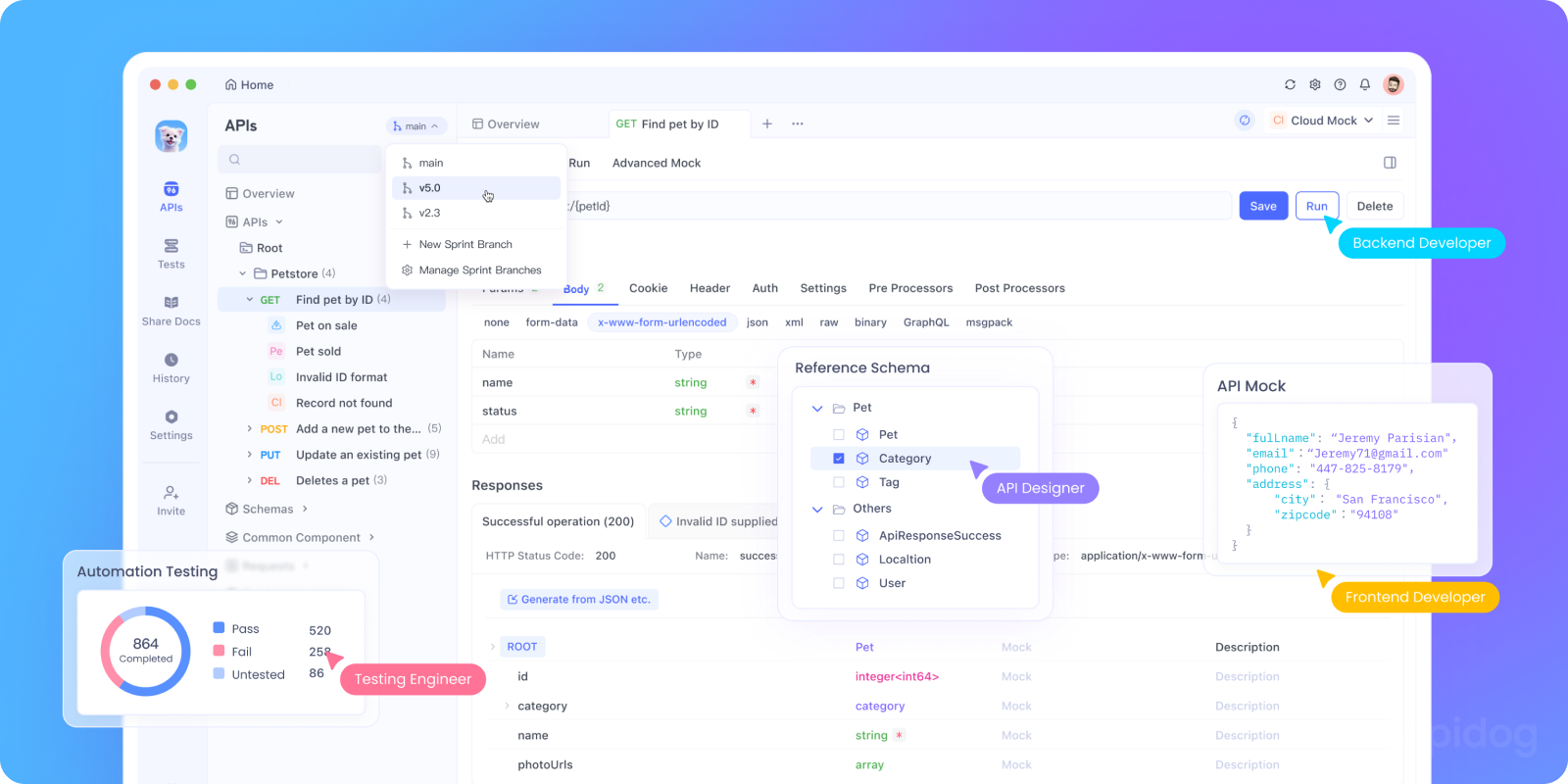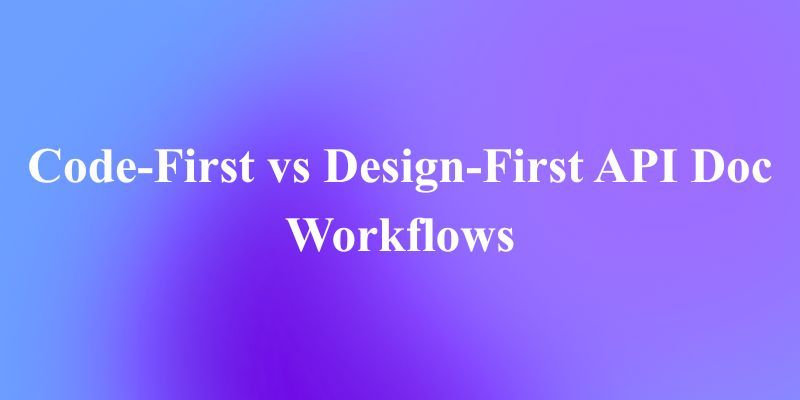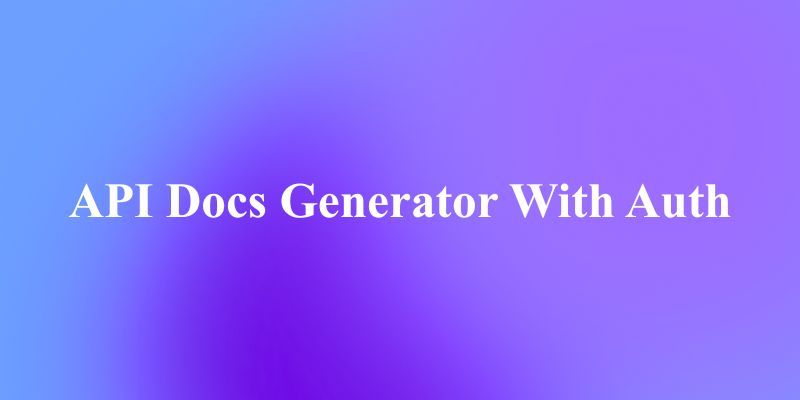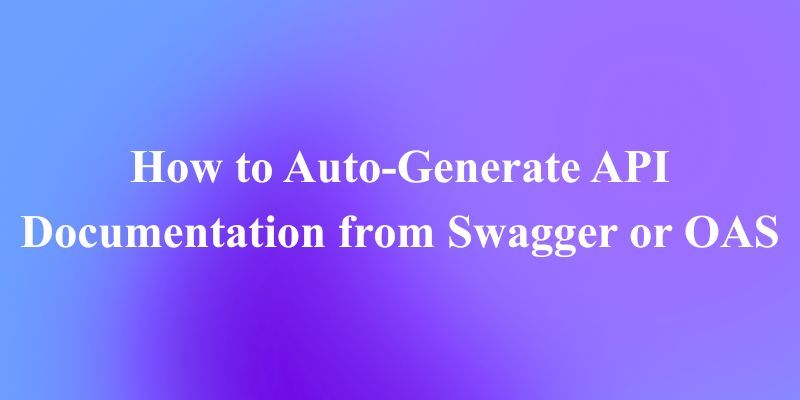When you're building APIs, one of the biggest questions you eventually face is:
"Should I use a code-first workflow or a design-first workflow for my API documentation?"
It's a question that developers, architects, and product owners debate all the time because the answer shapes your development velocity, your documentation quality, and even your API governance strategy.
And here's the thing:
There's no single "correct" answer. Instead, each workflow has its strengths and choosing the right one depends on your team structure, collaboration needs, tech stack, and long-term API strategy.
What is Code-First API Workflow?
The code-first approach is exactly what it sounds like: you write your API implementation first, and the documentation is generated from the code itself.
How Code-First Workflow Works
In a code-first workflow, developers focus on building the actual API endpoints, controllers, and business logic. The documentation becomes almost a byproduct of the development process through:
- Annotations in Code: Developers add special comments or annotations directly in their source code.
- Documentation Generation Tools: Tools like Swagger/OpenAPI generators parse these annotations.
- Automatic Documentation: The tools generate API documentation, usually in OpenAPI format, that describes what was built.
The Code-First Mindset
The code-first philosophy says: "Let the developers build what they need to build, and we'll document it as we go." It's a practical, developer-centric approach that prioritizes implementation over upfront design.
What is Design-First API Workflow?
The design-first approach flips the script: you design and document your API contract before writing any implementation code.
How Design-First Workflow Works
In a design-first workflow, teams start by designing the API specification using tools that support OpenAPI or other API description languages. The process typically looks like:
- Collaborative Design: Product managers, frontend developers, and backend developers collaborate on the API design.
- API Contract First: Teams create a complete API specification describing all endpoints, request/response formats, and error handling.
- Review and Agreement: Stakeholders review and approve the API design.
- Parallel Development: Frontend and backend teams can work simultaneously using the agreed-upon contract.
- Implementation: Backend developers implement the already-designed API.
The Design-First Mindset
The design-first philosophy says: "Let's agree on what we're building before we start building it." It's a strategic, contract-first approach that prioritizes clear communication and planning.
The Detailed Comparison: Pros and Cons
Let's break down each approach across several key dimensions.
Development Speed and Iteration
Code-First:
- ✅ Fast Initial Development: Developers can start coding immediately without design overhead.
- ❌ Slower Iteration: Making changes requires code modifications, testing, and redeployment.
- ❌ More Rework: If the API design needs significant changes, developers must refactor working code.
Design-First:
- ✅ Faster Iteration: Design changes happen in the specification, which is quicker to modify than code.
- ❌ Slower Start: Teams spend more time in the design phase before any code is written.
- ✅ Less Rework: Since the design is agreed upon upfront, implementation is more straightforward.
Team Collaboration
Code-First:
- ❌ Developer-Centric: Primarily involves backend developers until later stages.
- ❌ Siloed Work: Frontend teams often wait for backend implementation to be complete.
- ✅ Technical Accuracy: The documentation exactly matches what's implemented (if maintained properly).
Design-First:
- ✅ Inclusive Process: Involves product managers, frontend developers, and stakeholders from the beginning.
- ✅ Parallel Work: Frontend can build mocks and prototypes while backend implements.
- ✅ Clear Communication: The API contract serves as a single source of truth for all teams.
Documentation Quality and Maintenance
Code-First:
- ❌ Documentation Drift: It's easy for documentation to become outdated if developers forget to update annotations.
- ✅ Always Available: Documentation is generated automatically from the codebase.
- ❌ Inconsistent Quality: Documentation quality depends on individual developer discipline.
Design-First:
- ✅ Consistent Quality: Documentation is created intentionally and reviewed before implementation.
- ✅ Always Current: The design specification is the source of truth that guides implementation.
- ✅ Comprehensive: Encourages thinking through error handling, validation, and edge cases upfront.
API Consistency and Design Quality
Code-First:
- ❌ Inconsistent Patterns: Different developers might implement similar endpoints differently.
- ❌ Design Debt: Quick implementation decisions can lead to awkward API designs that are hard to change later.
- ✅ Practical Implementation: APIs are designed based on what's actually needed and implementable.
Design-First:
- ✅ Consistent Patterns: The entire API is designed holistically, leading to better consistency.
- ✅ Thoughtful Design: More consideration given to usability, versioning, and long-term maintainability.
- ❌ Potential Over-Engineering: Risk of designing features that are difficult or impractical to implement.
Code-First vs Design-First: Key Differences
| Area | Code-First | Design-First |
|---|---|---|
| Starts with | Application code | API contract (OpenAPI) |
| Primary audience | Backend developers | Cross-functional teams |
| Documentation quality | Automated but sometimes messy | Clean, predictable, standardized |
| Mock APIs | Harder to generate early | Very easy to create |
| Governance | Weak | Strong |
| Speed to begin coding | Very fast | Requires planning |
| Parallel development | Limited | Excellent |
Already you can see why the debate exists each method optimizes for different needs.
The Hybrid Approach: Getting the Best of Both Worlds
Many successful teams use a hybrid approach that combines elements of both methodologies:
- Start with Lightweight Design: Create high-level API designs without getting bogged down in details.
- Implement Core Functionality: Build the essential endpoints using a code-first approach.
- Formalize the Specification: Generate OpenAPI specs from the working code.
- Refine and Extend: Use the generated spec as a starting point for designing new endpoints.
This approach maintains development velocity while ensuring good API design and documentation.
How Apidog Supports Both Code-First & Design-First API Workflow

Regardless of which approach you choose, having the right tools makes all the difference. Apidog is designed to support both code-first and design-first workflows seamlessly.
For Design-First Teams:
- Visual API Designer: Create and edit API specifications with an intuitive visual interface.
- Collaboration Features: Share designs with team members for feedback and review.
- Mock Servers: Generate mock APIs instantly from your designs so frontend teams can start working immediately.
- Version Control: Manage different versions of your API design as it evolves.
For Code-First Teams:
- OpenAPI Import: Import existing OpenAPI specifications generated from your code.
- Automatic Documentation: Keep your documentation in sync with your implementation.
- Testing Integration: Test your implemented endpoints against your API specifications.
- Documentation Hosting: Publish beautiful, interactive documentation for your users.
For Hybrid Teams
Apidog shines brightest here. It allows:
- round-trip sync
- development in code or design mode
- spec-driven tests
- auto-generated docs
- CI/CD compatibility
This is perfect for:
- startups scaling to mid-sized teams
- microservice architectures
- enterprises with strict governance requirements
Apidog becomes the "central truth" for APIs.
The Apidog Advantage:
What makes Apidog particularly powerful is its ability to bridge the gap between design and implementation. You can start with a design, implement the API, test it within the same platform, and keep everything synchronized.
Making the Decision: Key Questions to Ask Your Team
Still unsure which approach to choose? Ask your team these questions:
- How important is API consistency and design quality?
- Do we have frontend and backend teams that need to work in parallel?
- Is this API for internal use or external consumers?
- How much time can we spend on upfront design versus rapid iteration?
- What's our team's experience level with API design principles?
Your answers will point you toward the right approach for your specific situation.
Best Practices for Success
If You Choose Code-First:
- Make Documentation Part of Code Review: Include documentation quality in your pull request reviews.
- Automate Documentation Generation: Set up CI/CD pipelines to automatically generate and publish documentation.
- Use Consistent Annotation Standards: Establish team standards for how to document APIs in code.
- Keep your code modular: Cleaner code = cleaner API documentation.
- Use strong annotation patterns: Pick a consistent annotation framework.
- Validate OpenAPI output: Tools like Apidog can help detect mismatches.
If You Choose Design-First:
- Involve All Stakeholders Early: Include frontend, backend, product, and even client developers in design discussions.
- Start with API Guidelines: Create design guidelines before starting specific API designs.
- Use Mock Servers: Give frontend teams something to work with immediately.
- Treat the Design as a Living Document: Continue to refine the design as you learn from implementation.
- Version your APIs from day one: Avoid future-breaking changes.
- Use validation tools: Apidog can validate your design against backend implementations.
Conclusion: It's About Finding Your Team's Rhythm
The code-first vs. design-first debate isn't about finding one "right" answer, it's about understanding the trade-offs and choosing the approach that fits your team, your project, and your organization's needs.
Code-first gives you speed and flexibility at the cost of potential design debt and collaboration challenges. Design-first gives you better collaboration and design quality at the cost of slower starts and potential over-engineering.
Many teams find that their ideal approach evolves over time. You might start code-first for rapid prototyping, then switch to design-first as your API matures and gains more consumers.
The most important thing is to be intentional about your choice. Discuss it with your team, consider your specific context, and don't be afraid to adjust your approach as you learn what works best for you.
And whichever path you choose, having the right tools makes all the difference. Apidog provides a flexible platform that supports both methodologies, helping your team create better APIs with less friction. Why not see for yourself how it can transform your API workflow?



